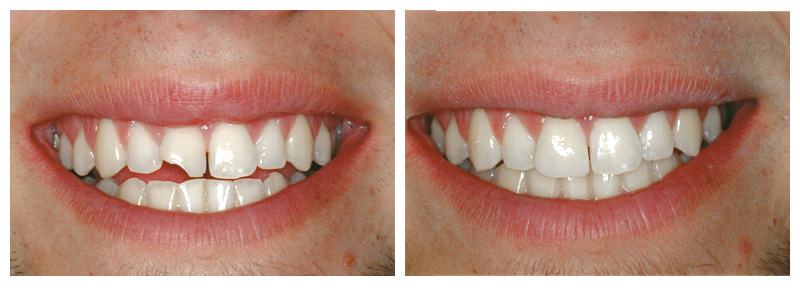What is a dental filling?
What is a dental filling?
A dental filling is a way to restore a tooth damaged by decay back to its normal function and shape. When a dentist gives you a filling, he or she first removes the decayed tooth material, cleans the affected area, and then fills the cleaned out cavity with a filling material.
By closing off spaces where bacteria can enter, a filling also helps prevent further decay. Materials used for fillings include gold, porcelain, a composite resin (tooth-colored fillings), and an amalgam (an alloy of mercury, silver, copper, tin and sometimes zinc).

Dental filling for tooth decay
Which Type of Filling is Best?
No one type of filling is best for everyone. What’s right for you will be determined by the extent of the repair, whether you have allergies to certain materials, where in your mouth the filling is needed, and the cost. Considerations for different materials include:
- Gold fillings are made to order in a laboratory and then cemented into place. Gold inlays are well tolerated by gum tissues, and may last more than 20 years. For these reasons, many authorities consider gold the best filling material. However, it is often the most expensive choice and requires multiple visits.
- Amalgam (silver) fillings are resistant to wear and relatively inexpensive. However, due to their dark color, they are more noticeable than porcelain or composite restorations and are not usually used in very visible areas, such as front teeth.
- Composite (plastic) resins are matched to be the same color as your teeth and therefore used where a natural appearance is desired. The ingredients are mixed and placed directly into the cavity, where they harden. Composites may not be the ideal material for large fillings as they may chip or wear over time. They can also become stained from coffee, tea or tobacco, and do not last as long as other types of fillings generally from three to 10 years.
- Porcelain fillings are called inlays or onlays and are produced to order in a lab and then bonded to the tooth. They can be matched to the color of the tooth and resist staining. A porcelain restoration generally covers most of the tooth. Their cost is similar to gold.

If decay or a fracture has damaged a large portion of the tooth, a crown, or cap, may be recommended. Decay that has reached the nerve may be treated in two ways: through root canal therapy (in which nerve damaged nerve is removed) or through a procedure called pulp capping (which attempts to keep the nerve alive).

Laser Lightwalker technology
What Happens When You get a Filling?
If your dentist decides to fill a cavity, he or she will first remove the decay and clean the affected area. The cleaned-out cavity will then be filled with any of the variety of materials described above.
How Do I Know if I Need a Filling?
Only your dentist can detect whether you have a cavity that needs to be filled. During a checkup, your dentist will use a small mirror to examine the surfaces of each tooth.

Anything that looks abnormal will then be closely checked with special instruments. Your dentist may also X-ray your entire mouth or a section of it. The type of treatment your dentist chooses will depend on the extent of damage caused by decay.
- Published in Dental Care, Tin tức
Wisdom tooth removal
Wisdom tooth extraction is a surgical procedure to remove one or more wisdom teeth — the four permanent adult teeth located at the back corners of your mouth on the top and bottom.
If a wisdom tooth doesn’t have room to grow (impacted wisdom tooth), resulting in pain, infection or other dental problems, you’ll likely need to have it pulled. Wisdom tooth extraction may be done by a dentist or an oral surgeon. Some dentists and oral surgeons recommend wisdom tooth extraction even if impacted teeth aren’t causing problems, as a preventive measure against potential future problems.

Wisdom teeth are the last of your teeth to come in, or erupt, through the gums. Sometimes a wisdom tooth becomes impacted, or stuck below the surface of your gums, and grows at an odd angle, possibly causing complications.
Wisdom teeth, or third molars, are the last permanent teeth to appear (erupt) in the mouth. These teeth usually appear between the ages of 17 and 25. Some people never develop wisdom teeth. For others, wisdom teeth erupt normally — just as their other molars did — and cause no problems.
Many people, however, develop impacted wisdom teeth — teeth that don’t have enough room to erupt into the mouth or grow normally. Impacted wisdom teeth may erupt only partially or not at all.

An impacted wisdom tooth may:
*Grow at an angle toward the next tooth (second molar)
*Grow at an angle toward the back of the mouth
*Grow at a right angle to the other teeth, as if the wisdom tooth is “lying down” within the jawbone
*Grow straight up or down like other teeth but stay trapped within the jawbone
You’ll likely need your impacted wisdom tooth pulled if it results in problems such as pain, infection, damage to an adjacent tooth, development of a fluid-filled sac (cyst) around the wisdom tooth, damage to surrounding bone, complications with orthodontic treatments to straighten other teeth

Preventing future dental problems
Dental specialists disagree about the value of extracting impacted wisdom teeth that aren’t causing problems (asymptomatic).
Here’s the rationale for preventive treatment:
*It’s difficult to predict future problems with impacted wisdom teeth.
*Symptom-free wisdom teeth could still harbor disease.
*Having your wisdom teeth makes you vulnerable to gum disease and tooth cavities.
*Removing impacted teeth lowers the risk of potential problems.
*Serious complications rarely happen in younger adults.
*Older adults may experience difficulty with surgery and complications after surgery.
*Other specialists argue that there isn’t enough evidence to suggest that impacted wisdom teeth not causing problems in young adults will later cause problems. Therefore, they suggest that the expense and risks of the procedure don’t justify the expected benefit.
- Published in Dental Care, Tin tức

